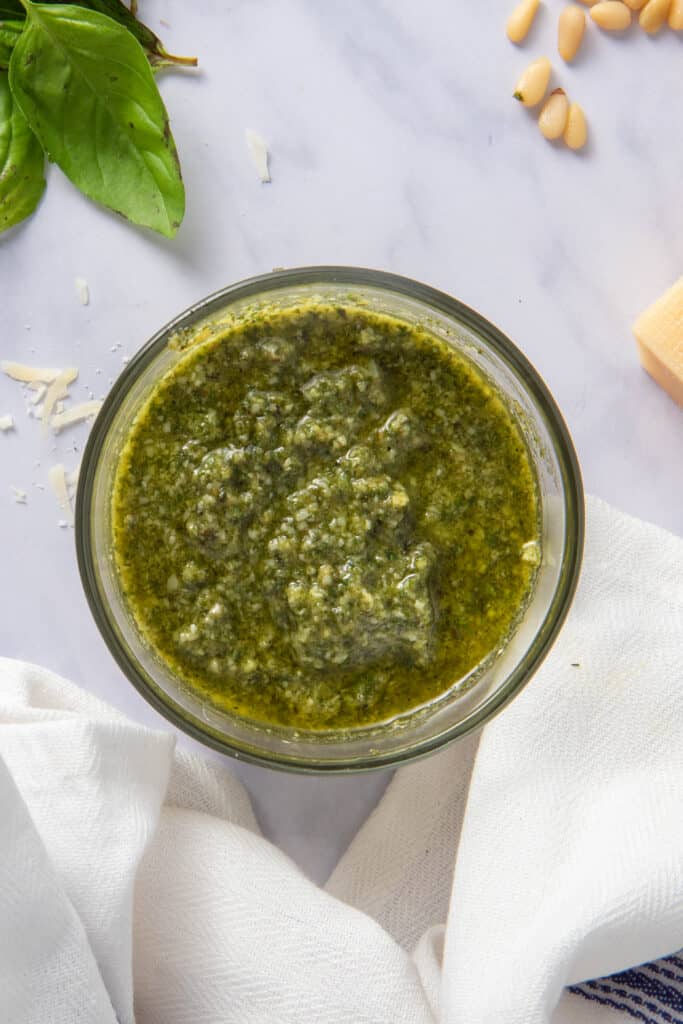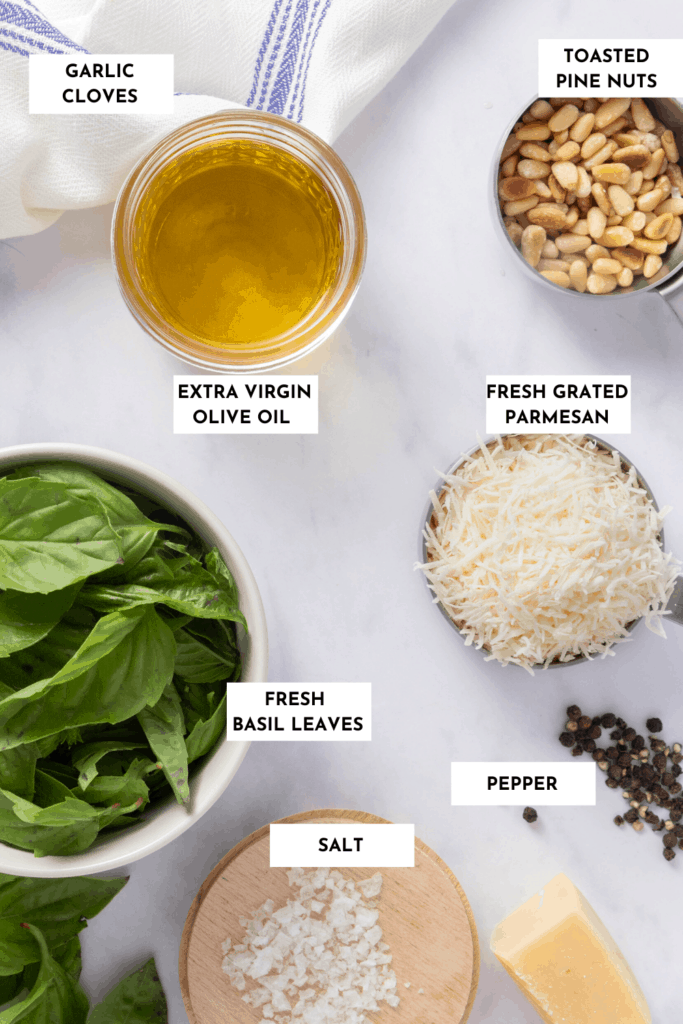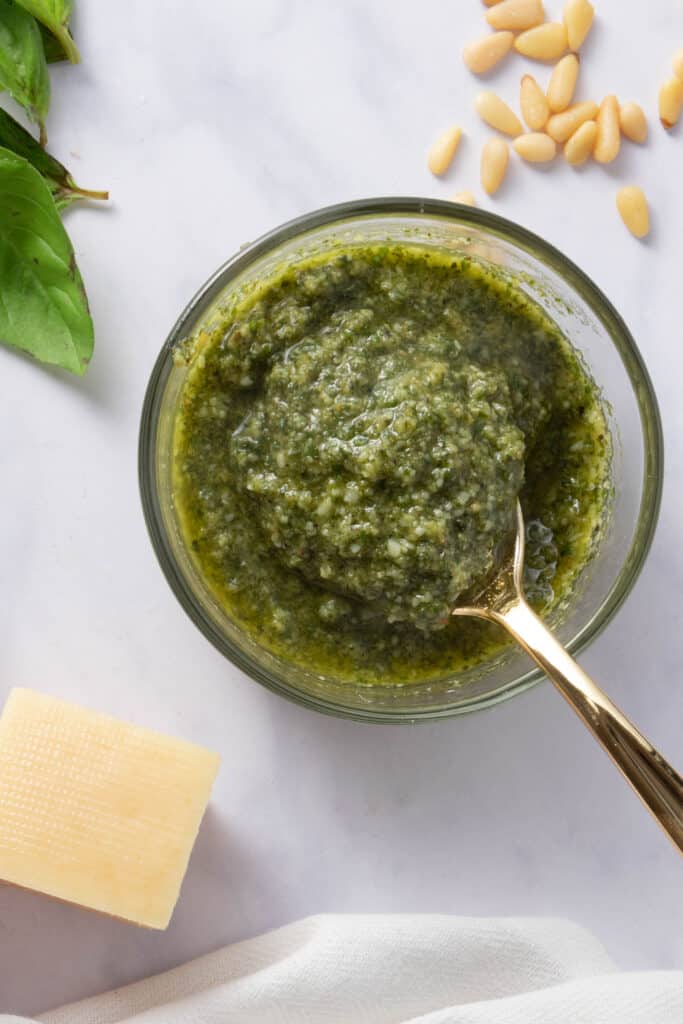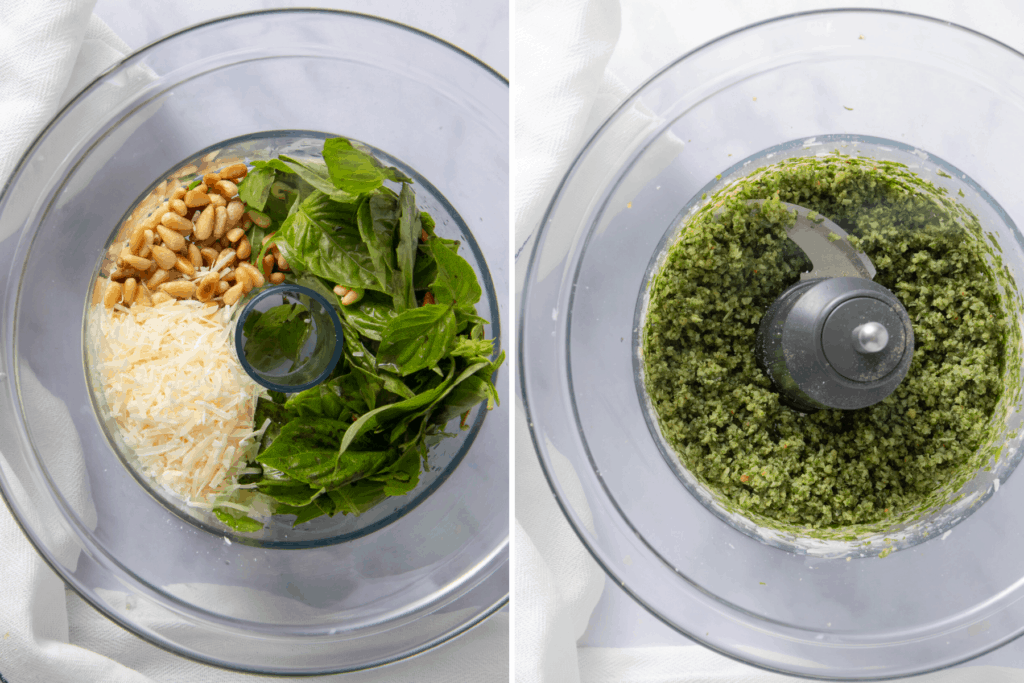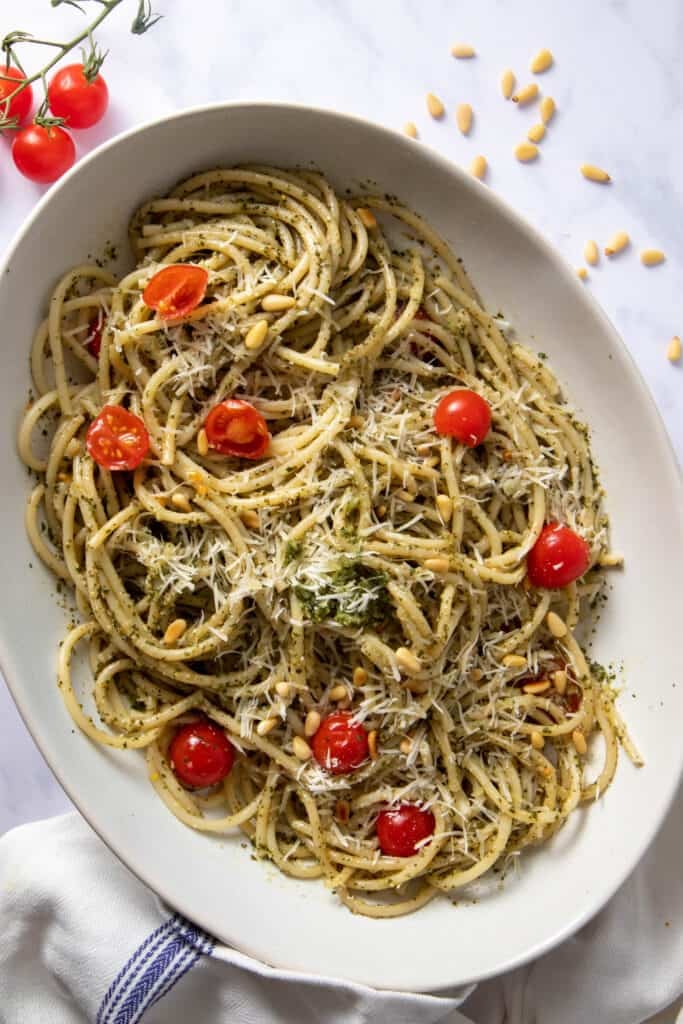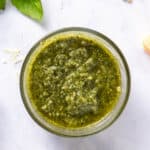This post contains helpful tips and tricks! If you’re in a rush, please use the “Jump to Recipe” above! Jump to:📋 Ingredients & variations👩🏽🍳 Top tips and troubleshooting 🍴 Eight ways to eat pesto (beyond pasta)📖 Recipe💬 Comments Pesto (meaning, “pounded” in Italian) has become a catch all word used to describe many different things today. It originated in Italy as a mortar-and-pestle ground, coarse sauce made of basil, pine nuts, garlic, Parmesan, and olive oil. Most Italians would accept that the traditional recipe we think about derives from Genoa, in Northern Italy, i.e. pesto alla Genovese.
📋 Ingredients & variations
Traditional pesto (aka pesto alla Genovese) is made with six ingredients. You need fresh basil, pine nuts, garlic, Parmesan, olive oil (preferably extra virgin) and salt. I use a recipe that I have been using for 6+ years now, since when I lived in Italy. This traditional recipe is simple, so the ingredients make a huge difference to the quality of your pesto.
🥬 What can I use instead of basil?
Basil is the traditional green that’s used to make pesto, but in recent times, kale has become the rebellious favorite. If you have the smallest spot or a nice airy and sunny area, you can grow basil at home! If not, you can even get a “living basil” pot from your grocery store and place it on your counter. But try to get the freshest basil you can for pesto!
However, you can use almost any type of green that has some structure and a mild bitter flavor. In addition to basil, I’ve made pesto with arugula (rocket), spinach, baby chard, carrot tops, and of course, blanched kale. I tend to use basil in the summer for basil pesto and kale in the winter.
🥜 What can I use instead of pine nuts?
Pine nuts are traditionally used in this recipe. But they can get expensive, so I’ve substituted them with almonds, walnuts, and more recently, cashews, to get incredible flavors. If you can’t get pine nuts (or prefer not to) you can use almost any nut or seed.
Based on a suggestion from Masterclass, I made pesto using pepitas (shelled sunflower seeds) for a friend who has a nut allergy. And it tasted quite delicious - so that’s my go-to option when I can’t find pine nuts. One thing you should do is to toast the nuts or seeds before you use them - this brings out the “nutty” flavor and adds some amazing notes to the pesto.
🧀 What kind of cheese should I use to make pesto?
The traditional recipe I’ve seen calls for parmigiano reggiano, but I’ve made pesto with similar hard, sharp cheeses (e.g. pecorino romano). I’ve left out the cheese entirely or added nutritional yeast or vegetarian Parmesan to accommodate dietary restrictions as well. You can leave it out when you’re grinding and add it at the end to your pasta directly too.
👩🏽🍳 Top tips and troubleshooting
How to make pesto?
You can make pesto with a food processor or a mortar and pestle. I’ve done both. One thing to note - the stainless steel blades will sometimes make the basil oxidize faster and lead to browning. To prevent that, I suggest placing the bowl and blades in the fridge for a few minutes before you grind pesto.
If your food processor does not have a spout for olive oil, no worries - just add by hand and mix slowly to combine. If using a mortar and pestle (or a “heavy” spatula) add ingredients slowly to combine them well.
Making creamy pesto
Traditional Italian basil pesto is not creamy, but most pesto available in US restaurants add cream to give it a richer flavor and consistency. One way to do this is to add cream (duh!). But I prefer a non-dairy way to accomplish the same effect: by using avocados instead. Avocados are delicious, full of good fat and add that creaminess that I often crave when I’m eating pasta. On that note, check out my creamy vegan kale pesto recipe (totally vegan) where I use avocados and cashews!
Using basil stems in your pesto
When the basil stem is too thick, it starts to get bitter. It can also mess up your food processor if it’s too “hard” - so I typically chop off older parts of the main stem. But the finer stems have never given me any trouble.
Cooking your pesto (please don’t!)
A quick note on serving pesto: you should never “cook” with pesto. The beauty of this sauce is in the fresh flavors that it brings out when added to almost any dish. For most pasta dishes, you cook the pasta almost al dente and then finish cooking the pasta in the sauce. This doesn’t work for pesto.
Instead, you should bring the pesto to room temperature. Once the pasta is cooked, reserve some of the pasta water. Then, transfer pasta to a mixing bowl, add pesto and some pasta water until it comes together. Bonus points for serving in a warm bowl so it doesn’t clump!
Storing and freezing your pesto
This really depends on the type of pesto and how you store it. I typically use airtight containers and store my pesto in the fridge. If I make ridiculous quantities (think, end-of-summer basil bounty) - I portion and freeze.
When stored in the fridge, pesto lasts 4 - 5 days on average, if continuously refrigerated. In the freezer, it lasts 2 - 3 months. That said, I’ve found that non-dairy recipes typically tend to keep a bit longer in the fridge. And if you used an avocado in the pesto, it does tend to brown a lot faster. To prevent pesto from browning, I’ll add a thin layer of olive oil on top.
🍴 Eight ways to eat pesto (beyond pasta)
Where do I even start with all the ways you can eat pesto?! Other than the delicious pasta (picture above, or like this pesto veggie pasta recipe) I’ve also rounded up eight ways in which you can devour this ultra versatile sauce. If you try this recipe, let me know! Leave a comment, rate the recipe, and tag #urbanfarmie on Instagram, @urbanfarmie on Pinterest!
📖 Recipe
If you tried this recipe, don’t forget to comment and rate! ⭐⭐⭐⭐⭐
